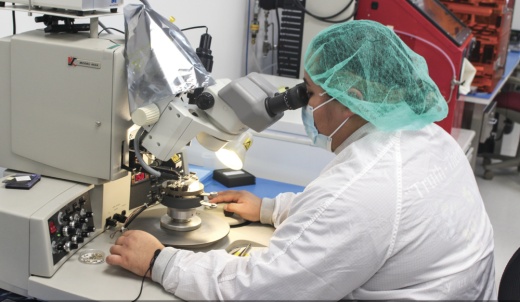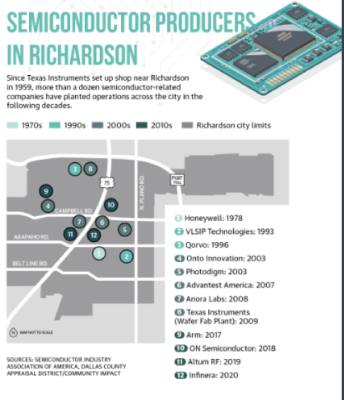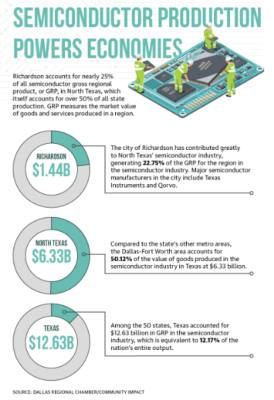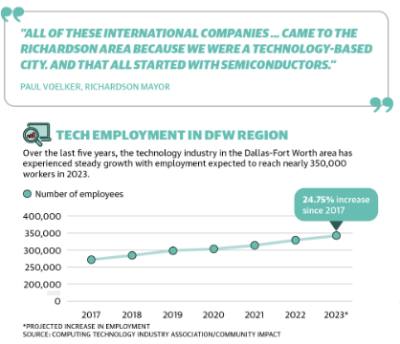The industry’s growth has greatly benefited Richardson’s tech-friendly business ecosystem, which has been defined by the rise in semiconductor production, Mayor Paul Voelker said.
“These [semiconductors] provide tools or software aiding our [other] local businesses, so it’s a significant industry for Richardson,” he said.
One of the ways the industry is expected to drive future growth in the city is by expanding local semiconductor production through the use of federal funding.
Signed into law last year by the federal government, the Creating Helpful Incentives to Produce Semiconductors and Science Act, or CHIPS and Science Act, is a bipartisan legislative package designed to create more jobs and lower production costs for semiconductor companies, including those in the Dallas-Fort Worth area.
It will provide $52.7 billion for American semiconductor research and development, manufacturing, and workforce development.
Since the passage of the act, U.S. Rep. Colin Allred, D-Dallas, has met with several local businesses that create semiconductor chips to gauge the region’s need for federal funding.
“We want to be self-sufficient in terms of creating our chips and make sure the next-generation chips are made properly,” he said during a visit. “We need to scale up and make sure that we can expand the use of the [technology] that’s going to have huge implications for our economy and for national security.”
One local company eyeing the federal funding is Photodigm, which develops speciality chips used in a variety of biomedical, sensing, environmental and defense technologies. The company was founded in 2000 as a spinoff of research at Southern Methodist University.
CEO Bill Stuart said utilizing federal funding would allow smaller companies like his to better compete with larger companies. He wants to expand operations at Photodigm’s headquarters by building a high-scale semiconductor fabrication facility, acquiring specialty equipment and hiring more employees.
“Even though we’ve been around a long time, there has been a limitation for us to really go out and make a name for the technology ... because we are limited by capital,” Stuart said.
Importance of semiconductors
Since the invention of the transistor in the 1940s, the semiconductor industry has become a key component of daily life in the digital age, according to Voelker.
Semiconductor chips are both a crucial component of the technology industry and already utilized by most Richardson residents, according to Texas Instruments officials.
“Nearly every device that plugs into a wall or contains a battery has a TI semiconductor in it,” TI spokesperson Ellen Fishpaw said via email. “Our approximately 80,000 products help over 100,000 customers.”
After opening operations near Richardson in 1956, TI’s demand for tech-related jobs in Richardson has contributed to a high volume of employment and a skilled workforce in the city. That led to the creation of what became The University of Texas at Dallas, which grew out of a private TI research arm, according to city officials.
The university later became instrumental in helping with the development of what became The Richardson Innovation Quarter, an economic district that city officials are working to make a “premier tech hub in Texas.”
In 2022, semiconductor businesses in Richardson generated $1.44 billion in gross regional product, which is a measure of the value of goods produced regionally, equal to 11.4% of the entire state’s output, according to the Dallas Regional Chamber.
As a whole, the Dallas-Fort Worth area contributed $6.33 billion in gross regional product and added 14,010 tech jobs in 2022, according to data from nonprofit trade association The Computing Technology Industry Association.
That same year, TI expanded its manufacturing facility in Richardson without federal funding with the addition of a second 300-millimeter wafer fabrication plant. According to TI officials, the new plant will support approximately 800 new jobs over time and manufacture more than 100 million chips every day at full production.
The ubiquity of semiconductor technology has helped position Richardson as a hub for innovation in other industries, Voelker said.
“It is the foundation of the technology that is Richardson,” he said. “The telecommunications industry was built off of the prowess of our semiconductor technology and the workforce that was here.”
Business-friendly community
According to City Manager Don Magner, maintaining that business-friendly balance is necessary to allow the city to offer a variety of special programs and events, including the Wildflower! Arts & Music Festival, while keeping the tax burden as low as possible on residents.
“We have to have a strong business ecosystem in order to keep our residential property tax as low as it is,” Magner said. “Having a diverse set of technology businesses operating and locating here will ensure our success in the future, and it also makes us much more resilient as an economy.”
In Richardson, 60% of property tax revenue is collected from commercial businesses with the remaining 40% obtained from homeowners. The city’s residential property tax reached its lowest point since 2006 during fiscal year 2022-23 alongside an increase in home values, according to city officials.
To recruit and retain companies, Richardson has positioned itself as an ally to tech businesses by its proximity to UT Dallas and offering multiple ways of getting around the city, according to Fishpaw.
Richardson officials said the city also offers case-by-case incentives to businesses to stimulate economic development, including tax abatements. Under Chapter 380 of the Texas Local Government Code, incentives that can be offered include property or sales tax rebates as well as lump sum payments to help businesses offset moving expenses, building costs and other expenses.
International tech businesses moving to the area have led to the development of most of the city’s cultural communities, Voelker said.
“All of these international companies .. came to the Richardson area because we were a technology-based city,” Voelker said “And that all started with semiconductors.”
Funding through CHIPS Act
As the demand for production increases for both general and specialized semiconductor chips, Stuart said the use of federal funding would be a real game changer for smaller companies such as Photodigm.
“It’s ... about the impact of innovation,” he said. “Our goal is to take our technology and lower the unit cost that it requires to make it so the product can compete price for price with other types of chips.”
In terms of equipment, Stuart plans to use federal funding to replace 20-year-old equipment with a new custom fabrication facility focused on the specialty chips the company produces. Stuart said he hopes to hire 200-250 employees for the new facility, which would be seven times its current workforce.
Businesses are expected to be accepted and announced for federal funding starting May 1, according to Photodigm officials.
Allred said the North Texas region is fortunate to have a long legacy of leading the semiconductor industry, and state and federal governments should keep investing in the region.
“If we don’t make these smart investments, then we’ve seen that industries can leave,” he said. “We don’t want that to happen in Richardson, but to do that, you have to keep innovating, keep making smart investments and keep bringing in smart people.”








